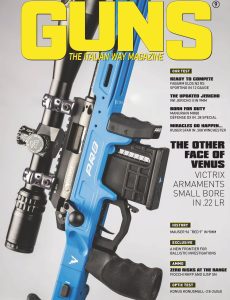
GUNS The Italian Way – Issue 09 – 2023
English | 90 pages | pdf | 136.99 MB
BUYBACK FASCINATES, BUT DOESN’T WORK!
Not even the time to settle on the most important seat in Brazil and the president Luiz Inacio Lula Da Silva has signed an executive order to tighten the legislation on guns, a decision in open contrast to the initiatives of his predecessor Jair Bolsonaro. Lula’s will is clear, even if for the moment nothing precise has been decided, and among the hypotheses under consideration the buyback project could not be missing, at least for some types of guns.
Responsibility for managing gun possession practices for hunters, shooters, collectors should be entrusted to the federal police and no longer to the armed forces. There is also talk of reducing the number of defense guns that can be held from 4 to 2; to reduce the number of ammunition that can be held for defense from 200 to 50 per year and the duration of arms licenses should also be reduced, from 10 years to 3 or 5, depending on the type of licence. Bad news also for sports shooters, who will be associated with the ability to purchase and hold based on experience level. Cleaver also on some calibers, as well as limitations should concern some types of weapons, such as modern semi-automatics.
On the other hand, comrade Lula had already promised it in the first days after his second election as president. And to think that there is no shortage of examples in the world of how useless and ineffective buybacks are. The Financial Post has analyzed the infamous weapons buyback program banned by the Trudeau administration in Canada, elaborating an updated cost estimate and making a comparison with one of the countries that has more recently carried out a similar initiative: the New Zeeland. In the Homeland of the Haka, the total cost of the operation for the administrative management of the surrending of guns, which did not only concern the “assault weapons”, but the vast majority of semi-automatic guns, was 31 million dollars, against the 16 estimated, while the amount of compensation for the value of the guns delivered was 106 million dollars.
In the decade leading up to the buyback, violent firearm crimes averaged 932 per year, the Canadian Business Journal said. In 2019, the year of the buyback, there were 1,142 crimes; in 2020, 1,156; in 2021, 1,338 and in 2022, 1,444, an increase of nearly 55% over the decade before the ban. “Evidently,” the newspaper article underlined, “New Zealanders have not become safer because the government has taken firearms away from law-abiding owners,” adding that according to the National Police Federation, the organization category of the Royal canadian mounted police, the buyback operation in Canada was “a costly initiative, unable to address the urgent threats to public safety, diverting personnel and resources that would, on the contrary, have been appropriate to use against the growing threat of criminal use of illegal firearms”.
Even current events do not leave too many doubts about the ineffectiveness of liberticidal measures, as demonstrated by the very serious news story that marred the debut of the women’s soccer World Cup in Auckland, New Zealand: a madman armed with a shotgun killed two people and injured others, some seriously, before being killed by police intervention. It should be emphasized that shotguns were also part of the buyback operation, but, apparently, it was not that difficult for the shooter to get hold of one. The perpetrator, among other things, did not have any license to legally purchase or possess weapons and this very aspect is proof that the very expensive buyback operation disarms law-abiding people, but has no effect on criminals and crazy.
Giulio Orlandini
Download from: